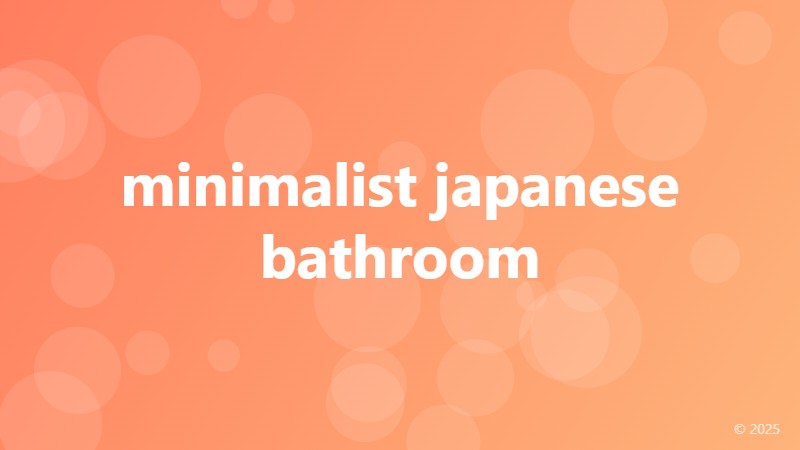minimalist japanese bathroom

The Simplicity of Minimalist Japanese Bathroom Design
A minimalist Japanese bathroom is a serene oasis that embodies the essence of simplicity and functionality. This design aesthetic has gained popularity worldwide, and for good reason. By incorporating natural materials, clean lines, and a focus on negative space, a minimalist Japanese bathroom creates a sense of calm and tranquility, making it the perfect retreat after a long day.
Natural Materials Take Center Stage
In a minimalist Japanese bathroom, natural materials such as wood, stone, and bamboo are often used to create a sense of warmth and coziness. These materials are not only aesthetically pleasing but also environmentally friendly. Wooden accents, such as reclaimed wood or cedar, add a touch of elegance and sophistication, while stone or bamboo flooring provides a natural, earthy feel.
The use of natural materials also helps to create a sense of continuity between the bathroom and the outdoors. This is particularly evident in Japanese design, where the boundaries between indoor and outdoor spaces are often blurred. By incorporating natural elements, the bathroom becomes an extension of nature, rather than a separate entity.
Clean Lines and Minimal Ornamentation
A hallmark of minimalist Japanese design is the use of clean lines and minimal ornamentation. This is particularly evident in the bathroom, where fixtures and fittings are often sleek and understated. A wall-mounted sink, toilet, and showerhead create a sense of openness and airiness, while a simple, rectangular bathtub provides a clean and uncluttered look.
The lack of ornamentation is not only visually appealing but also serves a practical purpose. With fewer fixtures and fittings to clean, maintenance is a breeze, and the bathroom remains clutter-free. This emphasis on simplicity also helps to create a sense of calm, as the eye is not drawn to unnecessary details.
The Importance of Negative Space
Negative space, or the empty space between objects, is a crucial element in minimalist Japanese design. By leaving ample space between fixtures and fittings, the bathroom appears more spacious and airy. This also helps to create a sense of flow, as the eye is able to move freely around the room.
In a minimalist Japanese bathroom, negative space is often used to create a sense of drama or surprise. For example, a large, open area may be punctuated by a small, carefully placed decorative element, such as a bonsai tree or a simple sculpture. This use of negative space adds visual interest and creates a sense of tension and release.
Bringing the Outdoors In
A key element of minimalist Japanese design is the incorporation of natural light and outdoor elements. Large windows, skylights, or sliding doors allow natural light to flood the bathroom, creating a sense of connection to the outdoors. This not only enhances the ambiance but also helps to reduce the need for artificial lighting.
The use of plants or green walls is another way to bring the outdoors into the bathroom. Not only do plants help to purify the air and reduce stress, but they also add a touch of natural beauty to the space. In a minimalist Japanese bathroom, plants are often used sparingly, adding a pop of color and texture to the space.
In conclusion, a minimalist Japanese bathroom is a true oasis of calm and tranquility. By incorporating natural materials, clean lines, and a focus on negative space, this design aesthetic creates a sense of simplicity and functionality. Whether you're looking to create a peaceful retreat or simply a functional bathroom, the principles of minimalist Japanese design are sure to inspire.